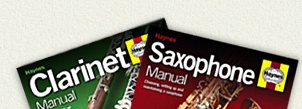

Curing sticky padsSticking pads can be the bane of the woodwind player's life. Having said that, it's something that affects players in varying degrees.Some hardly notice the occasional sticky pad, others find it compromises the playability of their instrument to such an extent that it's almost impossible to rely on the instrument in any real capacity. So what's the answer? Well, you'd have thought the solution would be to replace the pad - and where the pad is old and evidently worn this is often the best recourse - but more often than not the pad that sticks is in good shape...new, even. There are several factors that cause pads to stick. The first, and most
obvious, is that they get wet in use. Granted, most of the moisture found
in the bore of an instrument is condensation - but it carries with it
fats and sugars that have been dissolved in the airstream. There's also
a certain amount of saliva that finds its way into the bore too. 'Operator' (that's you, the player) factors that contribute towards sticky pads are eating, drinking, smoking...and breathing. Pick three out of that list and try not to do them before playing. A non-existent bore-swabbing routine doesn't help matters - though ironically enough there are times when it can actually worsen the problem. See the Lab Test pages for further details. There are quite a few products on the market that claim to be able to cure or prevent pads from sticking. The most common and widely available are the powders. Essentially these are little more than talc, the theory being that they absorb the gunk that collects on the pad and provide a means of dry lubrication. The truth of the matter is they make a hell of a mess and eventually exacerbate the problem. All you're really doing is adding yet more gunk to the surface of the pad - and once you start using the stuff you find you have to keep using it to cure the stickiness that the talc contributes towards. Another popular solution is called pad dope. Typically these are oils - such as neatsfoot. The claim here is that these products are supposed to waterproof the pad, the theory being that if you can stop the water from being absorbed by the pad then it won't stick. The problem is the oil itself can contribute to the stickiness, and the goo present in the condensation can still deposit itself on the pad whether it's waterproof or not. Such treatments are analogous to spilling a glass of beer on your kitchen floor and cleaning it up by throwing powder or oil on it, and hoping it goes away. The outlook then is bleak. Cleaning and degreasing the pad is an effective solution. There are no
magic ingredients and potions involved - just plain old ordinary lighter
fluid - and common or garden cotton buds (American readers will know these
as "Q-Tips"). If you find a cotton bud a bit of a tight fit, use a pipe cleaner - though bend it in half first so as not to risk the wire core puncturing the pad. You may have to make a couple of applications if the pad is particularly gummed up - and if it's that bad then maybe it really is time to have it replaced. For flutes and clarinets you can use a piece of cotton cloth, a corner of which you moisten with lighter fluid. Place this corner under the pad and very gently close the key onto the cloth. Slowly and gently drag the cloth out. It's worth pointing out that this method can shorten the life of a skin pad - so you might well find it enough to merely press the key down onto the moistened cloth and leave it at that. Sax pads often suffer from an excess of dried saliva deposits, and you
might well find that a cottonbud soaked in a little saliva will be the
best cleaning method. Follow it up with the lighter fluid though. Some people advocate the use of Crocus paper, which is an extremely fine
grade of carborundum paper. These methods work, but are best used sparingly because of the associated risks of damaging the pad. In any event, following up with lighter fluid is a good bet for a 'belt and braces' approach. I've often seen comments to the effect that lighter fluid will harm the pads, the reason given that it "dries out the leather's natural oils". This is easy enough to test, and in my workshop sits the skin of a used pad which has been subjected to at least a weekly sloosh of lighter fluid for the last couple of years*. That's a very great deal more lighter fluid than you'll be likely to apply to a pad in its lifetime - and yet the leather shows no sign of disintegrating. I feel duty bound to point out that lighter fluid is highly flammable - so please bear that in mind if you decide it would be a neat idea to ungunk your pads before a blazing log fire. Lighter fluid is also a deeply dangerous and unpleasant drink. *It's been almost a decade now, and although the leather now only
gets a sloosh in passing from time to time (I got bored of waiting for
it to fall apart), it's still in good nick. |
If you've enjoyed this article or found it useful and would
like to contribute
towards the cost of creating this independent content, please use the button
below.